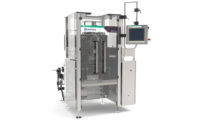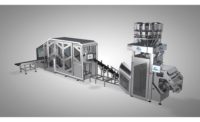Today’s form/fill/seal (FFS) systems accommodate a wide range of packaging options at high speeds, and provide packaging formats that bring convenience to shoppers. In effect, they have evolved to enable manufacturers to respond to market changes in package size and format. This is helping bakery and snack producers meet demand for single-serve, portion-controlled and calorie-conscious packs, as well as many other options.
Latest developments
The trend toward mass customization and small batch production requires machine designs with quick-change modules that make mechanical changes from one bag format to another easy and repeatable. “These innovations allow a single machine to accommodate changes in package size, but also style such as pillow, quad and stand-up zipper. This new technology is producing better looking bags and at higher rates of speed,” says Sean Riley, senior director, media and communications, PMMI, Reston, VA.
New advances in FFS systems are being developed around the need to run a wider range of packaging sizes on various types of film materials on one machine and at high speeds. This requires machinery to continuously feed material and adjust dynamically for different film characteristics when changeovers are required.
New FFS machines can produce packaging that ranges from traditional pillow packs and gusseted bags to more appealing stand up doy-pack bags with zippers in one continuous motion at high speeds. This is accomplished by using servo technology. “These same advances also help brand owners who are looking for more sustainable packaging materials. The new materials are often thinner and require more critical sealing parameters that servo-driven machines provide,” says John Panaseny, CEO, Rovema North America, Norcross, GA.
The latest advances in FFS systems include versatility, sanitation and operator-friendly features, according to Kim Magon-Haller, marketing manager, Triangle Package Machinery Co., Chicago. “In the past, most bakery and snack producers were simply looking to run a specific bag style. Today, as they look to run a wider variety of package styles on the same machine, FFS manufacturers are introducing more ways to do just that.”
Sustainability concerns are gaining traction as well, which means bakery and snack producers are closely examining their packaging materials. “FFS machines need to handle different packaging formats as well as materials such as monomaterial films, bio-based plastics and paper. This poses a challenge for sealing technologies, which have to be adjusted to the characteristics of the new materials,” says Josua Schwab, product manager, Bosch Packaging Technology, Beringen, Switzerland.
Improving production
FFS equipment recently introduced to the bakery and snack market reflects many of these trends. For example, tna solutions pty. ltd., Sydney, Australia, offers the tna robag FX 3ci vertical form, fill and seal (VFFS) machine, which can achieve efficiencies of up to 250 bags per minute using rotary triple, double, single or flat jaw configurations to package a variety of bag types. “The machine also helps users increase profits by reducing waste from 0.5 percent to 1 percent. In addition, the tna robag FX 3ci facilitates ease of maintenance and accessibility, and has quick wipe-down surfaces for cleaning,” says Shayne De la Force, chief marketing officer. The machine is suitable for packaging fried, baked, puffed, extruded and pellet snacks.
Bosch Packaging Technology recently introduced three FFS systems:
- The entry-level Pack 102 flow wrapper with robotic integration for cookies, which can handle up to 50 picks per minute.
- A customized bar system that can package up to 1,500 products per minute. The Sigpack TTM1 top-load cartoner is one of the bar system’s highlights: the machine either loads the flow-wrapped products into 24-count display cartons or fills them directly into a work-in-process tray.
- The SVE 2520 DZ for vertical FFS was shown for the first time with a polyolefin film for more sustainable packaging. The material is suitable for a wide range of products and can produce up to 100 Doy zip bags per minute.
Triangle Package Machinery recently introduced the Compact Sanitary Bagger, which features a frame width of only 36 inches and can run bags from 2.5 to 13 inches wide and up to 15 inches long. Sanitation features include improved accessibility and maintenance. Another key benefit of this VFFS bagger is the ability to pair two compact baggers side-by-side with a single filler to maximize production.
“Even in a side-by-side configuration, the bagger’s small footprint is similar in size to that of typical single-tube baggers,” says Magon-Haller. “This allows customers to achieve more production within the same footprint without having to add feeding systems, labor and floor space. It also provides the flexibility to run varying film structures or film rolls.”
Campbell Wrapper Corp., De Pere, WI, offers the Revolution Horizontal Flow Wrapper, which features a servo-driven film feed roll, sanitary modular design, servo cutting head drive for accurate cutoff adjustment and production speeds of up to 600 packages per minute. The machine can be integrated with automatic feeders, code daters and cartoners.
The Campbell Revolution comes standard with a web width of 16 inches, with optional web widths available, and features such as: out-of-position product-no cut, high product detector, slack web detector and stainless steel/wash-down construction. “It produces packages for a wide range of applications such as bakery and confections, frozen foods and snack bars,” says Graham Nice, regional sales manager.
VolPak America, Covington, KY, has introduced the SC+ high-speed, continuous motion pouching machine, which combines next-generation sealing technology with continuous motion filling to achieve high speeds. “This new technology provides the flexibility in pouch sizes that VolPak equipment is known for with minimum changeover times required when switching pouch formats,” says Marty Bechtel, sales director. VolPak machines can run various types of materials and pouch styles, including new sustainable materials.
Rovema North America recently introduced the BVC 260 and 400 Flex FFS machines to address the need for a high level of package and film flexibility all within a compact footprint. “The machines have been well received, particularly by bakery and snack producers that have plants with space constraints. This new equipment gives their marketing teams a number of options to meet customer packaging requirements,” Panaseny says.
Mike McCann, packaging specialist at Reiser, Canton, MA, says the introduction of his company’s Variovac line of FFS machinery has been well received. The line augments Reiser’s Repak FFS lines, inline tray sealers, vacuum bagging lines and stretch wrapping systems. “All of these lines integrate seamlessly with industry-wide loading solutions and our servo-driven belt loading systems, and our robotic loading, case loading with vacuum detection, and complete boxing and palletizing solutions.”
Looking ahead
What near future advances are on the horizon for FFS systems? Some manufacturers envision smart AI (artificial intelligence) machines that will self-diagnose issues and schedule parts and service without human intervention. “The biggest advances will be in the area of IoT or Industry 4.0 with machine monitoring and predictive maintenance designed to improve overall operational efficiency,” Panaseny predicts.
The future lies in the integration of the IoT and AI, adds De la Force. “IoT sensor-embedded machines that track use-and-duty cycles will combine with AI to create an operational platform that enables planned and critical maintenance, and automates repetitive tasks. Rapid development of sensor technologies, AI and machine learning capabilities are catalyzing these advances.”
With the current emphasis on sustainability, research will continues to focus on the handling of new materials, including recyclable, compostable and biodegradable structures. These thinner, more elastic materials present FFS challenges that involve temperature sensitivity, tension and web-handling, and package aesthetics. Riley predicts that more advances are coming in the area of sealing technology to support these new materials.







